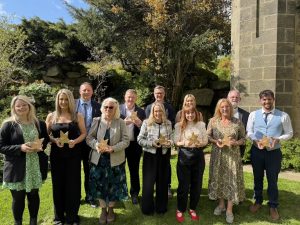Emerging Trends in Consumer Behavior

The past year’s changes, from the COVID-19 pandemic to economic instability, political unrest, and AI making more and more visible presence in our daily feed, have left consumers feeling overwhelmed, leading to noticeable behavior shifts.
Understanding those shifts and current shopper behavior research is absolutely crucial to deliver meaningful products, services, experiences or communication.
Types of Consumer Behavior
There are four main consumer behavior types: complex, dissonance-reducing, habitual, and variety-seeking. These behaviors influence purchasing decisions differently, depending on the product’s cost and frequency of purchase.
Complex Buying Behavior
Complex behavior involves high-involvement purchases like cars or homes, where consumers research extensively and commit deeply due to the high costs.
Dissonance-Reducing Buying Behavior
Dissonance-reducing behavior is when consumers, highly involved but struggling to differentiate between brands, worry about regretting their choice. It’s common in purchases like flat-screen TVs or engagement rings.
Habitual Buying Behavior
Habitual behavior occurs with regular, emotionally unattached purchases, like bread or gasoline.
Variety Seeking Buying Behavior
Variety-seeking behavior is when consumers try different products within the same line, like a new toothpaste brand, for novelty rather than dissatisfaction.
Online Shopping Trends
Shopping online evolves. From brand discovery to making purchases, different generations are doing so in arange of non-traditional methods. Staying updated with consumer online shopping behavior is a must, when you want to keep up with fast paced changes. Luckily, with simple online research tools, you can run a professional study and get meaningful results easily. More on that subject to be found here: https://www.realeye.io/blog/eye-tracking-software
Online inspiration for purchases is growing
The way people find products is changing. While search engines remain popular, social media platforms’ algorithm-based recommendations are gaining popularity. Platforms like TikTok have integrated purchase features to make their sites more shoppable. Google has revamped their search tools to cater to the demand for a more visual approach to product discovery. This trend is driven by younger consumers, with 59% of Gen Z preferring to shop online and 49% using the internet for inspiration, compared to just 36% of boomers.
Personalized recommendations popular among Gen Z
In the US, younger generations (Gen Z and millennials) prioritize tailored recommendations and eco-friendly delivery when shopping online. On the other hand, older generations focus more on practical aspects such as free returns, secure payments, and loyalty points.
A/B testing helping to deliver product and content that work
A/B testing is one of the simplest, yet effective ways to test your marketing, strategic and creative choices. It is creating 2 versions of a digital asset to see which one users respond to better. In an A/B test, half of your audience receives “version A” and half receives “version B.” The performance of each version is based on conversion rate goals, such as the percentage of people who click on a link, complete a form, or make a purchase.
If you want to grow your business, it can be difficult to determine which marketing strategies resonate the most with your audience. A/B testing, along with other conversion optimization strategies, allows you to try things out, improve your content, provide better customer experiences, and reach your conversion goals faster. What is even more encouraging, you can run a complete A/B test with no additional equipement! Using software like RealEye – webcam eye tracking tool makes A/B testing easy and accessible.
Forecasting Consumer Trends
When forecasting future consumer behaviors you take a step back and think of macro drivers influencing how people think, feel and act, and from there – what products, services and experiences would consumers need for those lifestyle choices. Building on the big picture, you can research emotions and attention patterns among concrete consumer groups, to get products, services and communication design right. More on measuring attention and emotions can be found here: https://www.realeye.io/features/online-webcam-facial-coding
4 Consumer profiles
These consumer profiles are based on sociographics rather than demographics. They are formed by shared values and ways of being, not age, although some may align more with certain generations.
The New Nihilists
The disillusioned ones. They do not see much value in the World right now. However, what is rather optimistic here is the shift towards a sense: there is simply nothing to lose in attempting to find a solution to all of this.
The Reductionists
They find themselves feeling disconnected and missing the human connections, which have been largely lost due to the pandemic. In response, they are focusing on creating new communities, rather than networks, while still taking advantage of technology.
The Time Keepers
Conscious of the cost, they are really stepping back from social platforms and technology. Since they know quite well they will live longer, this group is very much into making the best of this time, while not being defined by stereotypical age concepts.
The Pioneers
These are the most pro-active ones. Powered by technology and innovation, seize every offered opportunity, following it and moving forward. Very demanding, taking the best of all possible lifestyles.
Key Ideas:
-
Understanding consumer behavior is crucial for businesses to thrive.
-
Contemporary trends shape how customers think, act, and make purchasing decisions.
-
Ethical practices, sustainability, and social responsibility are important in consumer behavior.
-
Businesses must remain agile, adaptive, and open to innovative ideas.
-
Technology, culture, and societal norms drive the evolution of consumer behavior.
-
Embracing innovation, data, and understanding the target market helps businesses stay ahead and seize growth opportunities.
Bibliography:
-
“2024 Global Consumer Trends”, https://www.mintel.com/consumer-market-news/global-consumer-trends/
-
“Decoding the Future: Your Consumer in 2025”, Carla Buzasi, CEO and President of WGSN, presentation from Cannes Lions 2023.
-
“Swipe, click, buy” – GWI deck – 2023.
-
“A Refresher on A/B Testing”, Amy Gallo https://hbr.org/2017/06/a-refresher-on-ab-testing
-
“Consumer Behavior Summer 2023 – Key Insights & Updates”, Commerce Pundit, https://www.linkedin.com/pulse/consumer-behavior-summer-2023-key-insights-updates-commercepundit/







